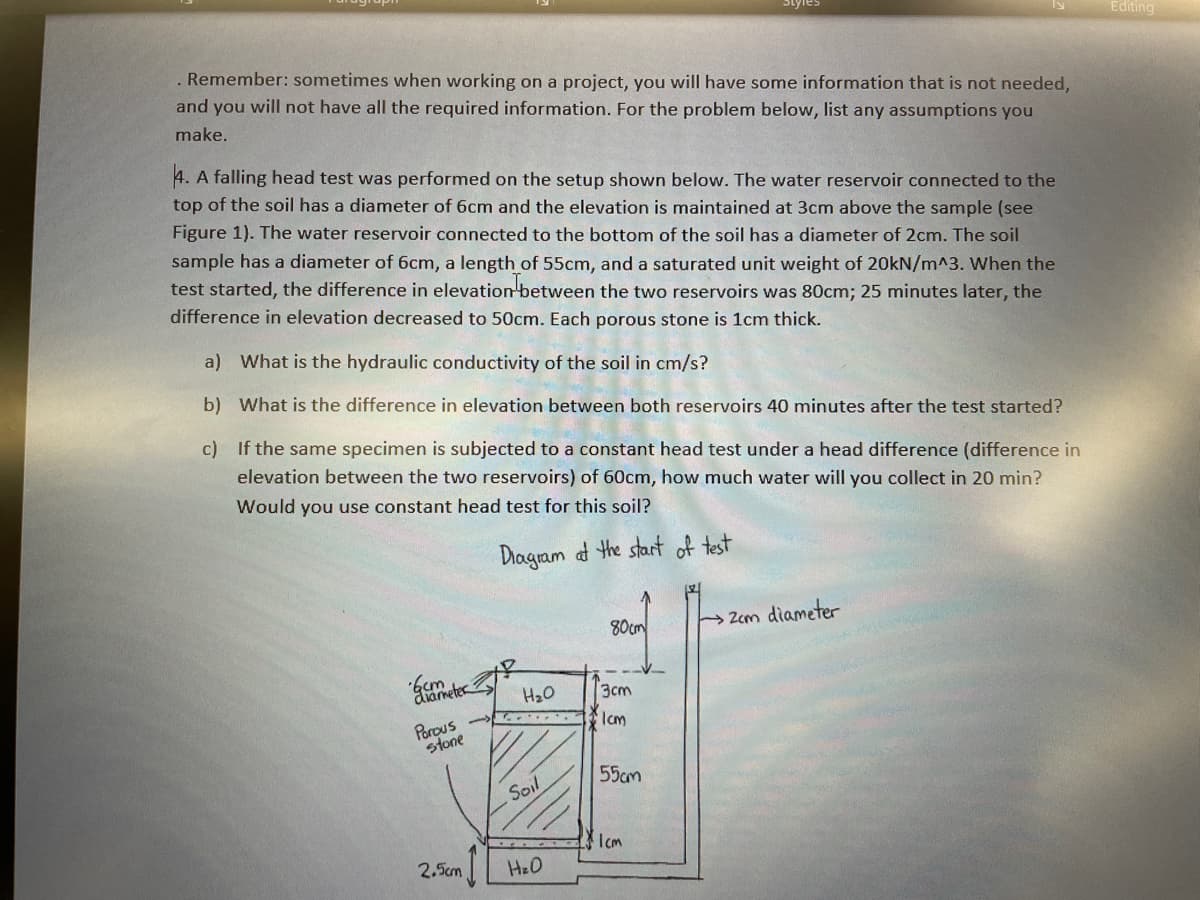4. A falling head test was performed on the setup shown below. The water reservoir connected to the top of the soil has a diameter of 6cm and the elevation is maintained at 3cm above the sample (see Figure 1). The water reservoir connected to the bottom of the soil has a diameter of 2cm. The soil sample has a diameter of 6cm, a length of 55cm, and a saturated unit weight of 20kN/m^3. When the test started, the difference in elevationbetween the two reservoirs was 80cm; 25 minutes later, the difference in elevation decreased to 50cm. Each porous stone is 1cm thick. a) What is the hydraulic conductivity of the soil in cm/s? b) What is the difference in elevation between both reservoirs 40 minutes after the test started? c) If the same specimen is subjected to a constant head test under a head difference (difference in elevation between the two reservoirs) of 60cm, how much water will you collect in 20 min? Would you use constant head test for this soil? Diagram ad the start of test 80cm zcm diameter ung. diameter H20 3cm Porous stone Icm 55cm Soil Icm 2.5cm
4. A falling head test was performed on the setup shown below. The water reservoir connected to the top of the soil has a diameter of 6cm and the elevation is maintained at 3cm above the sample (see Figure 1). The water reservoir connected to the bottom of the soil has a diameter of 2cm. The soil sample has a diameter of 6cm, a length of 55cm, and a saturated unit weight of 20kN/m^3. When the test started, the difference in elevationbetween the two reservoirs was 80cm; 25 minutes later, the difference in elevation decreased to 50cm. Each porous stone is 1cm thick. a) What is the hydraulic conductivity of the soil in cm/s? b) What is the difference in elevation between both reservoirs 40 minutes after the test started? c) If the same specimen is subjected to a constant head test under a head difference (difference in elevation between the two reservoirs) of 60cm, how much water will you collect in 20 min? Would you use constant head test for this soil? Diagram ad the start of test 80cm zcm diameter ung. diameter H20 3cm Porous stone Icm 55cm Soil Icm 2.5cm
Fundamentals of Geotechnical Engineering (MindTap Course List)
5th Edition
ISBN:9781305635180
Author:Braja M. Das, Nagaratnam Sivakugan
Publisher:Braja M. Das, Nagaratnam Sivakugan
Chapter19: Drilled Shaft
Section: Chapter Questions
Problem 19.10P
Related questions
Question

Transcribed Image Text:Editing
. Remember: sometimes when working on a project, you will have some information that is not needed,
and you will not have all the required information. For the problem below, list any assumptions you
make.
4. A falling head test was performed on the setup shown below. The water reservoir connected to the
top of the soil has a diameter of 6cm and the elevation is maintained at 3cm above the sample (see
Figure 1). The water reservoir connected to the bottom of the soil has a diameter of 2cm. The soil
sample has a diameter of 6cm, a length of 55cm, and a saturated unit weight of 20kN/m^3. When the
test started, the difference in elevation between the two reservoirs was 80cm; 25 minutes later, the
difference in elevation decreased to 50cm. Each porous stone is 1cm thick.
a) What is the hydraulic conductivity of the soil in cm/s?
b) What is the difference in elevation between both reservoirs 40 minutes after the test started?
c) If the same specimen is subjected to a constant head test under a head difference (difference in
elevation between the two reservoirs) of 60cm, how much water will you collect in 20 min?
Would you use constant head test for this soil?
Diagram ad the start of test
80cm
Zem diameter
diameter
H20
3cm
Porous
stone
Icm
55cm
Soil
Icm
2.5cm
I HeO
Expert Solution
This question has been solved!
Explore an expertly crafted, step-by-step solution for a thorough understanding of key concepts.
This is a popular solution!
Trending now
This is a popular solution!
Step by step
Solved in 4 steps with 1 images

Knowledge Booster
Learn more about
Need a deep-dive on the concept behind this application? Look no further. Learn more about this topic, civil-engineering and related others by exploring similar questions and additional content below.Recommended textbooks for you

Fundamentals of Geotechnical Engineering (MindTap…
Civil Engineering
ISBN:
9781305635180
Author:
Braja M. Das, Nagaratnam Sivakugan
Publisher:
Cengage Learning

Fundamentals of Geotechnical Engineering (MindTap…
Civil Engineering
ISBN:
9781305635180
Author:
Braja M. Das, Nagaratnam Sivakugan
Publisher:
Cengage Learning